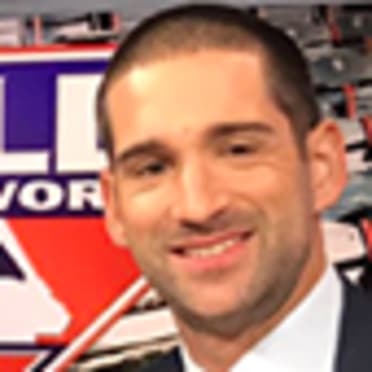We expect these prospects to debut in 2021
There was a lot we'd like to forget about 2020, which also happened to feature the shortest and strangest Major League season we'll probably ever see. But ascendant talents such as Luis Robert, Cristian Pache and Ke'Bryan Hayes will remember the year more fondly as the one in which they made their big league debuts.
Which top prospects will break into the Majors in 2021? We present the top contender for each club below, highlighted by the first three guys on MLB Pipeline's Top 100 Prospects list: Rays shortstop Wander Franco, Orioles catcher Adley Rutschman and Padres left-hander MacKenzie Gore. Don't be surprised if they're joined by the next prospect on the Top 100, Tigers corner infielder Spencer Torkelson, even if the No. 1 overall pick in the 2020 Draft has yet to get his first official at-bat in pro ball.
AMERICAN LEAGUE EAST
Blue Jays: Simeon Woods Richardson, RHP (No. 4/MLB No. 93)
A former Mets second-round pick (2018) who joined the Blue Jays in the 2019 Marcus Stroman deal, Woods Richardson, 20, would have likely pitched in Double-A this season if not for the pandemic. Instead, the right-hander spent the season at Toronto’s alternate training site, where he continued to progress in his overall development. He’s advanced for his age and demonstrates excellent control of four above-average or better offerings, giving him a bright future in Toronto’s rotation.
Orioles: Adley Rutschman, C (No. 1/MLB No. 2)
He only has 130 official pro at-bats to date, but he was the best player at the team’s alternate training site in Bowie over the summer, wowing the Orioles with his attention to detail and his all-around tools that made him the clear choice to be the No. 1 pick in the 2019 Draft. It shouldn’t take him too long to make it to Baltimore and become the face of the franchise.
Rays: Wander Franco, SS (No. 1/MLB No. 1)
The baseball world spent most of 2020 on standby for a potential Franco callup. That never happened, of course, although the teenage switch-hitter did finish the season on Tampa Bay’s postseason taxi squad. As a career .336/.405/.523 hitter who’s racked up 71 extra-base hits, 110 RBIs and more walks (83) than strikeouts (54) in his first two seasons, it shouldn’t take Franco long to gain a national audience with his elite hitting ability.
Red Sox: Jeter Downs, SS/2B (No. 1/MLB No. 40)
The key prospect received from the Dodgers in the Mookie Betts trade last February, Downs could take over Boston's second-base job at some point during the season. The 2017 supplemental first-rounder from a Florida high school has yet to play above Double-A, but hit .276/.362/.526 with 24 homers and as many steals in 2019.
Yankees: Luis Gil, RHP (No. 5)
The Yankees' most advanced prospects -- Clarke Schmidt, Deivi García, Estevan Florial, Albert Abreu and Miguel Yajure -- made their big league debuts in 2020 so we'll go out on a limb here with Gil, who had made just three starts as high as Class A Advanced but possesses an electric arm. Signed out of the Dominican Republic for $90,000 in 2015 by the Twins and traded for Jake Cave three years later, he has a lively fastball that reaches 100 mph and a power breaking ball with slider velocity and curveball shape.
AMERICAN LEAGUE CENTRAL
Indians: Nolan Jones, 3B (No. 1/MLB No. 38)
Though José Ramírez isn't going anywhere, Jones could play a significant role on the 2021 Indians by shifting from the hot corner to plug a hole on an outfield corner. The 2016 second-round selection from a Pennsylvania high school offers an impressive combination of left-handed power and patience that produced 15 homers and a Minor League-leading 96 walks in 2019.
Royals: Daniel Lynch, LHP (No. 3/MLB No. 54)
The No. 34 overall pick in the 2018 Draft, Lynch may have the best stuff in the Royals’ system, boasting a fastball in the mid- to upper-90s that he complements with a devastating slider and a curveball and changeup that both continued to improve this past summer at Kansas City’s alternate training site. He has all the ingredients needed to become a starter in the big leagues, and there’s zero doubt that the 6-foot-6 southpaw would thrive in a bullpen role on the strength of his fastball-slider combo.
Tigers: Matt Manning, RHP (No. 3/MLB No. 20)
Manning was shut down due to a balky right elbow in late August, but the former first-round pick (2016) is expected to be fully healthy by Spring Training. So long as that’s the case, it shouldn’t be all that long before the 22-year-old righty joins fellow Tigers pitching prospects Casey Mize and Tarik Skubal in the team’s big league rotation. He possesses perhaps the best pure stuff of the three hurlers, featuring a fastball that reached triple digits during Spring Training, a plus curveball and a changeup that continues to improve.
Twins: Royce Lewis, SS (No. 1/MLB No. 7)
Based on how he played at the Twins’ alternate training site, Lewis picked up where he left off from his Arizona Fall League MVP season in 2019. He’s worked hard on using his lower half better with his swing, with positive effects in terms of continuing to drive the ball, all while improving his defense at short. Jorge Polanco is entrenched at that position, though he’s pushed though injuries, but Lewis showed in the AFL he’s capable of playing second, third and center field.
White Sox: Andrew Vaughn, 1B (No. 1/MLB No. 13)
At some point early in the season, Vaughn should make an already formidable White Sox offense even more dangerous by getting regular at-bats between first base and DH. The No. 3 overall pick in the 2019 Draft out of California, he's one of the better college offensive prospects in recent memory and projects as a potential .300 hitter with 30 homers and 80 walks on an annual basis.
AMERICAN LEAGUE WEST
A’s: Grant Holmes, RHP (No. 24)
It’s been a bit of a long road for the one-time Dodgers first-round pick (2014), one that included missing nearly all of 2018 with shoulder issues. He bounced back with a strong 2019 and continued to work on harnessing his stuff during his alternate training site time this past summer. He still has one of the best breaking balls in the system and just needs to refine his command to get a crack at the big league rotation.
Angels: Brandon Marsh, OF (No. 1/MLB No. 73)
A change in his setup at the plate in 2019, standing more upright, started really helping Marsh offensively in 2019 and carried over into the AFL. That continued with his performance at the Angels’ alternate training site to go along with his plus defense and speed. Yes, Jo Adell scuffled in his debut in 2020, but Angels fans should be excited to see Marsh and Adell flank Mike Trout at some point in 2021.
Astros: Forrest Whitley, RHP (No. 1/MLB No. 17)
Whitley seemed headed toward making his big league debut in 2018 as a 20-year-old, but has been delayed much longer than expected by a 50-game suspension for violating the Minor League drug program plus minor oblique and lat injuries (2018), shoulder inflammation and command issues (2019) and the shortened season plus a sore elbow (2020). The 2016 first-rounder from a Texas high school still shows the makings of five plus pitches, however, and the Astros have a fluid rotation.
Mariners: Jarred Kelenic, OF (No. 1/MLB No. 9)
In a perfect world, we’ll see both Kelenic and Julio Rodriguez join Kyle Lewis in the Mariners' outfield in 2021, but it does appear that Kelenic is a step ahead of his younger organization-mate. That, plus all the news of him demolishing the baseball during Spring Training and at the club's alternate training site point to the potential five-tool player being ready to bash down the big league door.
Rangers: Josh Jung, 3B (No. 1/MLB No. 50)
The No. 8 overall pick in 2019 out of Texas Tech, Jung was one of the most advanced hitters in his Draft class and could take over at third base for the Rangers early next season. He made progress with pulling the ball for power at the alternate training site and in instructional league while also improving his defense at the hot corner and getting some action at shortstop, second base and the outfield.
NATIONAL LEAGUE EAST
Braves: Drew Waters, OF (No. 2/MLB No. 22)
Waters just turned 22 and should be just about ready to join Atlanta and form the exciting young outfield of Ronald Acuña Jr., Cristian Pache and Waters that everyone can’t wait to see. The switch-hitter makes loud contact, with power to come, runs well and plays plus defense with a plus arm. The only thing he needs to do his refine his approach a bit to cut down on the K/BB ratio.
Marlins: JJ Bleday, OF (No. 2/MLB No. 24)
Miami put Bleday on the fast track by sending him immediately to Class A Advanced after selecting him fourth overall in the 2019 Draft. He led NCAA Division I with 27 homers and 192 total bases while leading Vanderbilt to the College World Series championship in his final college season, and he could be the most productive corner-outfield option for the suddenly resurgent Marlins in 2021.
Mets: Thomas Szapucki, LHP (No. 8)
The former fifth-round pick (2015) returned from a nearly 22-month absence due to Tommy John surgery in 2019 to work a career-high 61 2/3 innings across three levels, including Double-A. The Mets believe in the 24-year-old southpaw’s abilities as a starter and he made progress in that role during a healthy summer at the alternate training site. But with his deceptive fastball and plus curveball, Szapucki may have a clearer path to contributing next season as a reliever.
Nationals: Cade Cavalli, RHP (No. 2)
The Nationals selected Cavalli with the No. 22 pick in this year’s Draft because they believed in his untapped potential on the mound and overall high ceiling. He offered a glimpse of that during his first pro summer, pitching in the upper-90s with nasty secondary offerings, and the Nats might have even called him up to pitch out of the bullpen had they been in the playoff hunt. Cavalli could be in the mix for that type of role once again in 2021, despite being viewed as a no-doubt starting pitcher long term.
Phillies: Francisco Morales, RHP (No. 4)
This might be a bit of a stretch as Morales has yet to pitch above the South Atlantic League, but the 21-year-old right-hander has the size (6-foot-4) and stuff to be the kind of young hurler who makes a huge leap in 2021. He’s added a ton of weight and strength to his frame and his fastball-slider combination alone is enough to get big league hitters out. The Phillies added him to the 40-man roster this offseason.
NATIONAL LEAGUE CENTRAL
Brewers: Corey Ray, OF (No. 10)
Ray appeared to be heading in the right direction after a breakout 2018 campaign in which he recorded 27 homers and 37 steals en route to Most Outstanding Player honors in the Double-A Southern League, but he struggled with the move up to Triple-A while battling injuries in ’19, then failed to reach the Majors this past season, despite being on Milwaukee’s 40-man roster. Now 26, Ray faces questions about his hitting ability but remains an elite athlete who has several big league-caliber tools in his speed, defense, and raw power.
Cardinals: Zack Thompson, LHP (No. 5)
The Cardinals made Thompson the highest-drafted player in University of Kentucky history in 2019, selecting the left-hander with the No. 19 pick. His stuff ticked up late in his pro debut while working out of Class A Advanced Palm Beach’s bullpen, and it’s conceivable that the 23-year-old could serve in a similar relief role for the big league club in 2021 without it necessarily impacting his long-term development as a starter.
Cubs: Miguel Amaya, C (No. 3/MLB No. 91)
Most of the Cubs' nearly-ready prospects already have some big league experience, so we'll cite Amaya, a two-time Futures Gamer who has yet to play above Class A Advanced. Chicago already has traded Victor Caratini and reportedly is shopping Willson Contreras, which could lead to an opportunity for Amaya. Signed for $1 million out of Panama in 2015, he's a quality defender with some offensive promise as well.
Pirates: Cody Bolton, RHP (No. 12)
Bolton took a nice step forward in 2019, pitching his way to Double-A. He learned there that he had work to do in terms of harnessing his stuff in the strike zone more consistently. He focused on that this summer, with good results, so he should be ready in 2021 to attack upper level hitters with his fastball and breaking ball in particular, both thrown with high spin rates, making them very hard to square up.
Reds: Nick Lodolo, LHP (No. 1/MLB No. 44)
Thought to be an advanced college lefty heading into the 2019 Draft, Lodolo lived up to that billing during his brief pro debut the summer after the Reds made him the No. 7 overall pick. He knew he had to work on his changeup to take the next step and he did just that over the summer, making big strides in use of the pitch and deception, giving him the chance to be an elite-level starter in the near future.
NATIONAL LEAGUE WEST
D-backs: Tommy Henry, LHP (No. 22)
Scouts viewed Henry as a pitchability left-hander coming out of the 2019 Draft, when the D-backs selected him in Competitive Balance Round B. But the 23-year-old pitched with increased velocity this past summer, with his normally pedestrian fastball reaching 96 mph, and his secondary stuff all taking a step forward as well.
Dodgers: Josiah Gray, RHP (No. 1/MLB No. 62)
The World Series champion Dodgers just keep cranking out talented prospects, and the next in line is Gray, whom they stole from the Reds (along with Jeter Downs, see above with the Red Sox) in a December 2018 deal that cleared roster space and salary by unloading Yasiel Puig, Alex Wood, Matt Kemp and Kyle Farmer. Gray began his college career at NCAA Division II Le Moyne (N.Y.) as a shortstop before blossoming into a 2018 supplemental second-rounder on the mound, where he now deals mid-90s fastballs and low-80s sliders.
Giants: Heliot Ramos, OF (No. 3/MLB No. 60)
When we last saw Ramos, he played in the SiriusXM All-Star Futures Game and reached Double-A as a 19-year-old in 2019. With his average or better tools across the board, the 2017 first-rounder as a Puerto Rican high schooler could factor into an unsettled Giants outfield.
Padres: MacKenzie Gore, LHP (No. 1/MLB No. 3)
The former No. 3 overall pick (2017) was in the mix for a callup until the very end and finished the season on San Diego’s postseason taxi squad. While the Padres would like to see Gore establish more consistency with his secondary pitches before they turn him loose at the highest level, it shouldn’t stop them from calling up their prized 21-year-old hurler to contribute in 2021. In his last full season (2019), Gore took home MLB Pipeline Pitcher of the Year honors after he ranked first in ERA (1.69) and WHIP (0.83), second in opponent average (.164) and fifth in strikeout rate (35.7 percent) among Minor League pitchers who logged at least 100 innings.
Rockies: Ryan Rolison, LHP (No. 2)
In a normal season, Rolison would have taken the lessons he learned during his first full season in hitter-friendly Lancaster and applied them to the upper levels this year. Even without those official reps, he’s worked on his balance and direction to the plate on the mound and his stuff should continue to tick upward as he reaches Coors Field.


